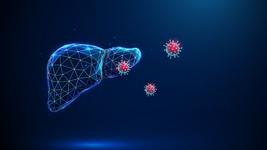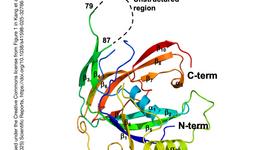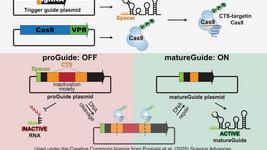CMN Weekly (22 April 2022) - Your Weekly CRISPR Medicine News
By: Gorm Palmgren - Apr. 22, 2022
Top picks
- Novel nanocapsules containing CRISPR reagents can penetrate the blood-brain barrier and lead to high gene-editing efficiency up to 38.1% with negligible (less than 0.5%) off-target editing in a glioblastoma brain tumour in mice. In addition, treatment with nanocapsules corrected a mutation in the PLK1 gene and extended the median survival time to 68 days versus 24 days in mock-treated animals. The nanocapsules are made of a glutathione-sensitive polymer shell incorporating a dual-action ligand that facilitates BBB penetration, tumour cell targeting, and Cas9/sgRNA selective release.
- Researchers in China have developed an upgraded prime editing platform (xrPE) with substantially enhanced editing efficiencies in multiple cell lines. The enhancement relies on appending a viral exoribonuclease-resistant RNA motif (xrRNA) to the 3'-extended portion of pegRNAs for their increased resistance against degradation Pan-target average enhancements of up to 3.1-, 4.5- and 2.5-fold in given cell types is observed for base conversions, small deletions, and small insertions, respectively.
Research
- Cryogenic-electron microscopy (cryo-EM) structures of Cas9-RNA-DNA complexes reveal that CRISPR-Cas9 sharply bends and under-twists DNA on PAM binding, thereby flipping DNA nucleotides out of the duplex and toward the guide RNA for sequence interrogation. The study by Jennifer Doudna's group explains how Cas9 'reads' snippets of DNA to locate target sites within a vast excess of non-target DNA, a process crucial to both bacterial antiviral immunity and genome editing.
- American researchers have demonstrated that CRISPR-Cas9-mediated GM-CSF knockout in CAR-T cells directly ameliorates CAR-T cell early activation, reduces activation-induced cell death, and enhances anti-tumour activity in vivo in a xenograft model. In addition, the researchers previously demonstrated that neutralisation of GM-CSF (granulocyte-macrophage colony-stimulating factor) could break the efficacy/toxicity linkage. This is caused by reducing cytokine release syndrome (CRS) and neuroinflammation (ICANS) while enhancing CAR-T function.
- Dual-gene editing with modular synthetic sgRNAs has been enabled using CRISPR-click. American researchers describe a modular strategy for synthesising sgRNAs where each target sequence is conjugated to a unique fluorescent label, enabling fluorescence-activated cell sorting (FACS) to isolate cells that incorporate the desired combination of gene-editing constructs.
- Researchers in China have developed poly(beta-amino esters) nanoparticles with improved backbones, side chains, and end caps to deliver plasmids of base editors and sgRNAs. The nanoparticles enabled the robust conversion of stopped-EGFP into EGFP after a single intratumor injection in mice bearing xenograft glioma tumours.
- David Liu and colleagues have used phage-assisted evolution to improve activity and expand targeting scope of double-stranded DNA-specific cytidine deaminase (DddA). The evolved DddA6 and DddA11 were used with DdCBE cytosine base editors and increased editing efficiencies by 3.3-fold over canonical DdCBEs and achieved editing in up to 50% of cells.
- Another base editor study shows that in vivo correction of an Rpe65 mutation by adenine base editor (ABE) prolongs the survival of cones in a Leber congenital amaurosis (LCA) mouse model. Subretinal delivery of ABE and sgRNA corrected up to 40% of Rpe65 transcripts, restored cone-mediated visual function, and preserved cones in LCA mice.
- Korean researchers have expanded the prime editing modality by using Cas9 nickase from Francisella novicida instead of the normal Streptococcus pyogenes Cas9 nickase. As a result, the targeting limitation is dramatically extended, and accurate prime editing is induced specifically for the target genes in human cell lines.
- Chinese researchers have constructed a mosaic SpCas9 protein (xCas9-NG) with improved editing efficiency in most targets. xCas9-NG is a fusion of the PI (PAM interacting) domain of SpCas9 PAM variant, Cas9-NG, with the non-PI fragment of xCas9 protein that contains multiple amino acid substitutions.
- Researchers in China have modified the sequence of gRNAs to introduce ligand binding sites based on the rational design of ligand–RNA pairs. The engineered gRNAs provide an excellent scaffold for binding small-molecule ligands and can be utilised for functional control of CRISPR-/Cas9 in vitro and human cells.
Industry
- Tessera Therapeutics has raised over $300 million in Series C financing to advance its GENE WRITING technology, an alternative to base editing, CRISPR and gene therapies. The technology is inspired by mobile genetic elements (MGEs). It can be used to change any base pair to any other, make small insertions or deletions, and write entire genes into the genome with the delivery of only RNA.
- Editas Medicine has appointed Gilmore O’Neill as Chief Executive Officer. He previously held leading positions at Sarepta Therapeutics and Biogen. Gilmore O'Neill succeeds James C. Mullen, who will continue to serve as Executive Chairman of the company's Board of Directors.
- EdiGene has entered into a research collaboration with Peking University Cancer Hospital to gene mutations related to advanced colorectal cancer. The research result is expected to enable the development of precision medicine for patients pre-screened by specific mutation patterns.
- AlloGene Therapeutics has announced the virtual unveiling of its manufacturing facility, Cell Forge 1 (“CF1”), located in Newark, California. The 136,000-square-foot facility is designed to support clinical trials and potential commercial production and worldwide distribution of allogeneic CAR T cell products for blood cancers and solid tumours.
Clinical
- SNIPR Biome has dosed the first human subjects in its Phase 1 clinical trial for SNIPR001, an orally administered CRISPR-based therapeutic designed to reduce E. coli colonisation in the gut. The ongoing Phase 1 trial aims to investigate the safety and tolerability of SNIPR001 in 36 healthy volunteers who will receive ascending doses of the candidate treatment and investigate its impact on E. coli colonisation in the gut. Read our coverage of the achievement here.
- Editas Medicine has announced the dosing of the first pediatric patient in the BRILLIANCE clinical trial of EDIT-101 to treat LCA10, a CEP290-related retinal degenerative disorder. It is the world’s first in vivo dosing of a pediatric patient with a CRISPR gene editing experimental medicine. Read our coverage of the achievement here.
News from AACR
- Several CRISPR companies have announced the news from the American Association for Cancer Research (AACR) Annual Meeting 2022: Nkarta, Qihan Biotechnology, Editas Medicine, Caribou Biosciences, Cellectis and Allogene Therapeutics.
Reviews
- A review by Danish researchers discusses how CRISPR-Cas can be used in diagnostics and therapy of infectious diseases. The review also investigates the current challenges of the technology and the improvements needed for the platform to be adopted for clinical use in patients.
News from CRISPR Medicine News
- In Wednesday's clinical update, we reported that SNIPR BIOME, Denmark, has dosed the first human subjects in its Phase 1 clinical trial for SNIPR001, an orally administered CRISPR-based therapeutic designed to reduce E. coli colonisation in the gut.
- The March edition of CMN Markets was out Tuesday, reporting that Intellia Therapeutics has dosed the first patient with its ex vivo candidate NTLA-5001 for acute myeloid leukaemia and received orphan drug designation for NTLA-5001. In addition, financial updates were provided by multiple gene-editing companies.
- Tuesday also saw our sister-site CRISPR AgroBio News (CARBON) launch its bi-weekly newsletter. The top story was that Chinese researchers have used CRISPR-Cas9 to switch the leaf colour in ornamental kale (Brassica oleracea) from pink to green.
- The clinical update of the previous Wednesday was about Editas Medicine having dosed the first child in the BRILLIANCE clinical trial of EDIT-101 for Leber congenital amaurosis 10, a rare form of hereditary blindness. This marks the first-ever in vivo administration of an experimental CRISPR therapy to a paediatric patient.
- The previous Monday, we published an explainer about the gene drive technology. Gene drives are genetic elements that can quickly spread through populations and have nearly a 100% chance of passing the genes they carry to the next generation. Synthetic gene drive is a technology of genetic engineering through which certain desired traits can be introduced to almost all individuals in a population. Researchers can either eliminate a species or alter the genetic makeup of living organisms through gene drive technology.
To get more of the CRISPR Medicine News delivered to your inbox, sign up to the free weekly CMN Newsletter here.
Tags
CLINICAL TRIALS
IND Enabling
Phase I
Phase II
Phase III
Gastric Cancer and Colorectal Cancer, CRC, (NCT07166263)
Sponsors:
Base Therapeutics (Shanghai) Co., Ltd.
Sponsors:
Base Therapeutics (Shanghai) Co., Ltd.
IND Enabling
Phase I
Phase II
Phase III
Relapsed or Refractory Acute Myeloid Leukemia, AML, (NCT06541444)
Sponsors:
Base Therapeutics (Shanghai) Co., Ltd.
Sponsors:
Base Therapeutics (Shanghai) Co., Ltd.
IND Enabling
Phase I
Phase II
Phase III







